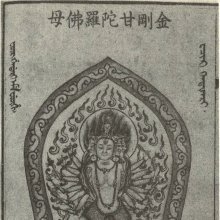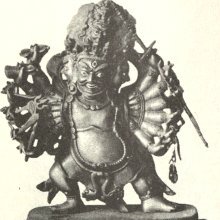Vajragandhari, Vajragāndhārī: 2 definitions
Introduction:
Vajragandhari means something in Buddhism, Pali, Hinduism, Sanskrit. If you want to know the exact meaning, history, etymology or English translation of this term then check out the descriptions on this page. Add your comment or reference to a book if you want to contribute to this summary article.
Images (photo gallery)
In Buddhism
Tibetan Buddhism (Vajrayana or tantric Buddhism)
Source: archive.org: The Indian Buddhist IconographyVajragāndhārī (वज्रगान्धारी) refers to one of the various emanations of Amoghasiddhi, as mentioned in the 5th-century Sādhanamālā (a collection of sādhana texts that contain detailed instructions for rituals).—Her Colour is blue; her Āsana is the pratyālīḍha; he has six faces and twelve arms.—The name of Vajragāndhārī is already mentioned in connection with the maṇḍala of the eight-armed Kurukullā, an emanation of Amitābha. In this maṇḍala it is definitely said that Vajragāndhārī should bear the image of his sire Amoghasiddhi on her crown. She is thus included in the family of Amoghasiddhi.
The Dhyāna (meditation instructions) of Vajragāndhārī described in the Sādhanamālā as follows:—
“Vajragandhari is blue in colour, six-faced and twelve-armed with brown hair rising upwards. She stands in the pratyālīḍha attitude, and her faces look terrible with bare fangs and three eyes. She carries in her six right hands 1. the vajra, 2. the bell marked with a vajra, 3. the sword, 4. the trident, 5. the arrow, and 6. the discus, and in the six left hands 1. the khaṭvāṅga, 2. the goad, 3. the bow, 4. the paraśu, 5. the noose and 6. the tarjanī against the chest. Her first face is blue, and the other five faces show five different colour. She rests on the sun supported by a double lotus.”

Tibetan Buddhism includes schools such as Nyingma, Kadampa, Kagyu and Gelug. Their primary canon of literature is divided in two broad categories: The Kangyur, which consists of Buddha’s words, and the Tengyur, which includes commentaries from various sources. Esotericism and tantra techniques (vajrayāna) are collected indepently.
Languages of India and abroad
Sanskrit dictionary
Source: Cologne Digital Sanskrit Dictionaries: Edgerton Buddhist Hybrid Sanskrit DictionaryVajragāndhārī (वज्रगान्धारी).—name of a goddess: Sādhanamālā 352.17 etc.
Sanskrit, also spelled संस्कृतम् (saṃskṛtam), is an ancient language of India commonly seen as the grandmother of the Indo-European language family (even English!). Closely allied with Prakrit and Pali, Sanskrit is more exhaustive in both grammar and terms and has the most extensive collection of literature in the world, greatly surpassing its sister-languages Greek and Latin.
See also (Relevant definitions)
Full-text: Ashtabhujakurukulla.
Relevant text
No search results for Vajragandhari, Vajragāndhārī; (plurals include: Vajragandharis, Vajragāndhārīs) in any book or story.
Related products

